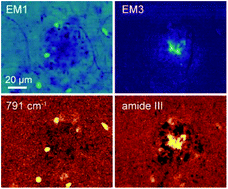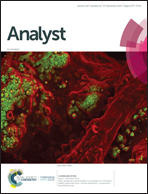A fingerprint of amyloid plaques in a bitransgenic animal model of Alzheimer's disease obtained by statistical unmixing analysis of hyperspectral Raman data
Abstract
The global prevalence of Alzheimer's disease (AD) points to endemic levels, especially considering the increase of average life expectancy worldwide. AD diagnosis based on early biomarkers and better knowledge of related pathophysiology are both crucial in the search for medical interventions that are able to modify AD progression. In this study we used unsupervised spectral unmixing statistical techniques to identify the vibrational spectral signature of amyloid β aggregation in neural tissues, as early biomarkers of AD in an animal model. We analyzed spectral images composed of a total of 55 051 Raman spectra obtained from the frontal cortex and hippocampus of five bitransgenic APPswePS1ΔE9 mice, and colocalized amyloid β plaques by other fluorescence techniques. The Raman signatures provided a multifrequency fingerprint consistent with the results of synthesized amyloid β fibrils. The fingerprint obtained from unmixed analysis in neural tissues is shown to provide a detailed image of amyloid plaques in the brain, with the potential to be used as biomarkers for non-invasive early diagnosis and pathophysiology studies in AD on the retina.



 Please wait while we load your content...
Please wait while we load your content...